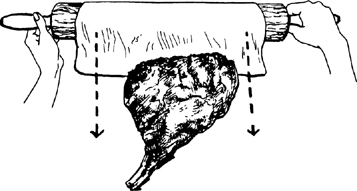Mastering the Art of French Cooking, Volume 2 (85 page)
Read Mastering the Art of French Cooking, Volume 2 Online
Authors: Julia Child

Even though you have the crust, there is not much of it per serving and you may also wish a potato dish such as the scalloped potatoes,
gratin dauphinois
, in Volume I on page 523, the
gratin
with cheese and cream following it, or the unusual
potato and endive
gratin
. Brussels sprouts,
broccoli, buttered spinach, or fresh green peas might also be included. This
gigot
naturally calls for the best in wines, giving you an opportunity to bring out your finest, château-bottled, red Bordeaux-Saint-Émilion.
THE CRUST, AND PUFF PASTRY VERSUS BRIOCHE DOUGH
Although puff pastry is traditional, it never quite cooks through when it covers rare-roasted meat, while
brioche
dough, if it is not allowed its final rise before baking, will form a crisp, brown crust. This question is discussed in the
preamble to Beef Wellington
, where you have the same choice.
For 10 to 12 people
1)
Boning the lamb
An 8- to 9-lb. leg of lamb (5 to 6 lbs. boned and minus sirloin)
Following illustrated directions preceding this recipe, remove tail and hip bones, main leg bone, and sirloin meat from leg of lamb. (If you are going to make the brown sauce suggested for Step 7, start it now, using the bones and scraps from the lamb.)
2)
Mushroom and kidney stuffing—farce duxelles aux rognons—2 cups
½ lb. (4 cups) fresh mushrooms
2 Tb butter and 1 Tb olive oil or cooking oil (more of each if needed)
A medium (10-inch) frying pan (no-stick recommended)
4 fine, fresh lamb kidneys, peeled and minced
3 Tb finely minced shallots or scallions
¼ cup port, Madeira, or Cognac
⅛ tsp each of ground thyme and rosemary
½ cup ground raw lamb (from the removed piece of sirloin)
¼ cup
foie gras
or
mousse de foie
(canned goose liver or liver mousse)
Optional but recommended: 1 or 2 minced truffles and their juice
Salt and pepper to taste
If needed: 2 or more Tb stale, not-too-fine crumbs from nonsweetened, homemade-type bread
Trim, wash, and dry the mushrooms. Chop into a fine mince with a big knife; a handful at a time, twist into a tight ball in the corner of a towel to extract as much juice as possible. Heat butter and oil in pan, and when butter foam has begun to subside, add the mushrooms. Sauté over moderately high heat, stirring, for several minutes, until mushroom pieces begin to separate from each other. Stir in the kidneys and shallots, adding a little more butter if you feel it necessary. Sauté, stirring, for 2 minutes, just to stiffen the kidneys. Pour in the wine or Cognac and herbs; boil down rapidly for 1 minute. Remove from heat. Stir in the ground lamb. Mash
foie gras
or
mousse
with a fork and stir in also, along with optional truffles and their juice. Season carefully to taste. (If by any chance mixture seems too damp or loose, stir in a tablespoon or so of bread crumbs to hold it together more.)
3)
Stuffing, tying, and skewering the lamb
Skewers and white string
Following the
illustrated directions
, pack the stuffing into the pockets left in the meat by the bones, skewer the large end of the meat, and lace closed with string.
(*)
AHEAD-OF-TIME NOTE
: Recipe may be prepared to this point a day in advance. Note also that you may prepare the sauce, Step 7, in advance.
4)
Preliminary roasting—30 minutes at 425 degrees, and a 30-minute rest
The stuffed and skewered lamb
A shallow roasting pan with rack
Cooking oil
Optional but recommended: an accurate meat thermometer
Preheat oven to 425 degrees. Wipe lamb thoroughly dry with paper towels and brush with cooking oil, especially on exposed lean-meat surfaces. Place on rack in roasting pan and set in upper-middle level of preheated oven. Basting once or twice with oil and turning meat once, roast 25 to 30 minutes, until lamb has swelled slightly and feels a little springy in contrast to its softer raw state. Meat thermometer reading: 120 degrees. Remove lamb from oven but leave string and skewers in place.
(*)
RESTING AND AHEAD-OF-TIME NOTES
: Lamb must rest for 30 minutes at least before final cooking, so that meat will draw together and hold stuffing in place. It must also cool off a little bit so that it will not overcook under its pastry, but it must not cool so much that it loses its juicy, freshly cooked character. If you are not ready to continue for some time, you may keep it perfectly for an hour or more anywhere that you can maintain a temperature of around 100 to 110 degrees, such as a warming oven, or the turned-off oven, reheating it for a moment every now and then.
5)
Enclosing the lamb in pastry—preheat oven to 450 degrees for next step
Either
the recipe for
simple puff pastry
;
Or
the recipe for
pain brioché
dough
, fully risen and ready to bake, but chilled
The still warm leg of lamb
A lightly greased jelly-roll pan, or edged baking sheet
Egg glaze (1 egg beaten with 1 tsp water in a small bowl)
A pastry brush
Optional but recommended: the meat thermometer
Remove string and skewers, and set lamb on pan or baking sheet. It is now to be enclosed in pastry; do so rapidly to prevent dough from softening and, in the case of
brioche
dough, from rising.



